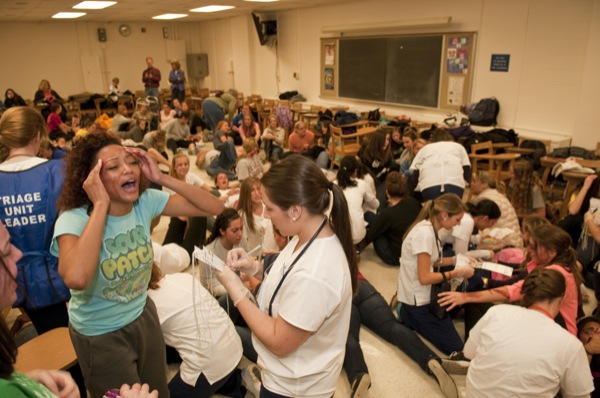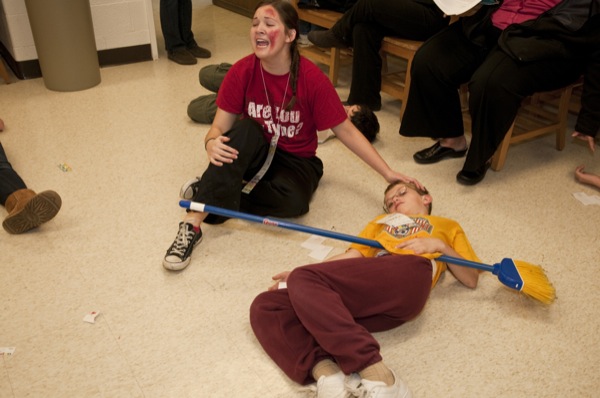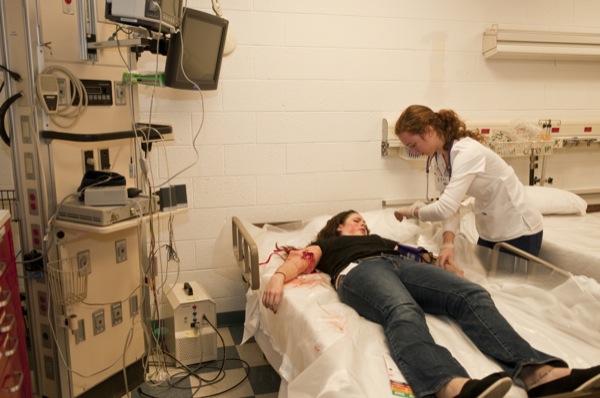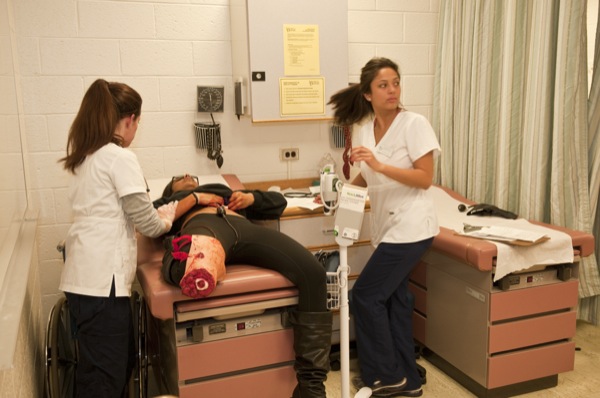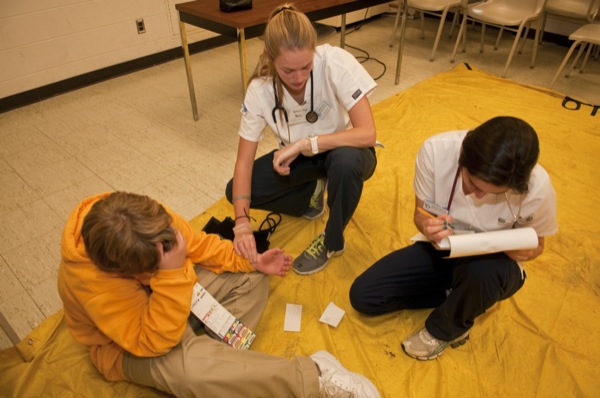

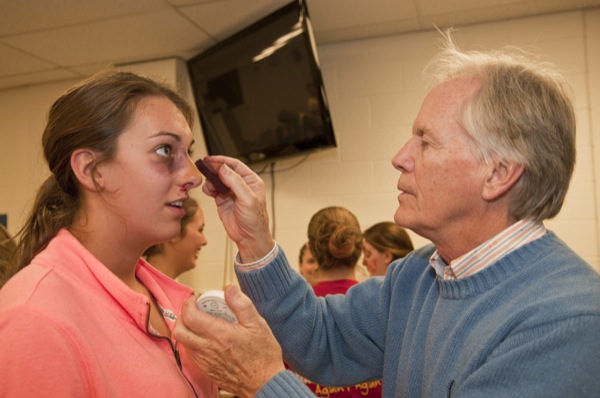
Preparing for the worst
Disaster drill participants ready nurses for the real thing
1:21 p.m., Dec. 4, 2012--A gray-haired man moans and clutches his heart. A young woman watches as blood rushes from a wound in her arm. A mother screams for help and strokes the face of her son, whose torso has been pierced by a wooden pole.
The scene is a simulated building collapse in the University of Delaware’s McDowell Hall, where future nurses are learning what to do during a disaster with mass injuries and casualties. The students are assigned a range of jobs during the drill, including hospital administrator, triage manager, air ground ambulance manager, transport nurse, and ICU nurse.
Campus Stories
From graduates, faculty
Doctoral hooding
The drill is repeated every semester, but new elements have recently been added to make the victim pool more diverse, the scene more realistic, and the reactions of the participants more authentic.
Two years ago, faculty in the School of Nursing began to consult with UD’s internationally renowned Disaster Research Center. Last year, graduate students from the School of Public Policy and Administration’s Disaster Science and Management Program observed the exercise in order to provide constructive feedback to the drill participants about the communication and coordination aspects of a disaster.
Healthcare Theatre joins the drill
Beginning in spring 2012, Amy Cowperthwait, adult health simulation lab coordinator in the School of Nursing, partnered with Allan Carlsen, assistant professor in the Department of Theatre, on the drill.
The two have a well-developed collaboration in UD’s Healthcare Theatre Program, which helps health care professionals develop communication skills through interactive scenarios presented by theatre students.
The “mother” whose “son” has been mortally wounded with the jagged wooden pole is Becky Ronan, one of eight theatre students participating in this year’s drill through the University’s new interdisciplinary undergraduate elective, “Healthcare Communication.” Ronan’s keening and pleas for help are chillingly realistic, and she cries real tears as the boy is carried to the morgue almost an hour after the accident.
For Carlsen, the challenge is always having an acting performance that “represents the truest fidelity.”
“When scenarios involve life-and-death situations,” he says, “the risk is the greatest whether it is physical, emotional, or psychological. Actors don't often have these performance opportunities, and improvisational disaster drills provide them. And knowing that your performances are for a greater good, besides entertainment, that is the icing on the cake.”
Ronan agrees.
“What happens during the drill in your mind the day before is nothing like what happens when you're really there,” she says. “I don't think any of us really knew just how many people there would be — I was kind of taken aback because I had not expected so many, but it just made it that much more realistic.”
Boy Scouts enter the fray
New to this year’s drill was the participation of five Boy Scouts, ages 11 and 12, who are working on emergency preparedness merit badges.
Cline Broussard played the part of a victim who suffered internal injuries after being hit in the abdomen by falling debris.
“Cline was a bit disappointed that he didn’t make it to OR — he died on the mat instead — and he would have liked to have gotten some cuts with blood or dismemberments, but other than that it was a great experience for him,” said his mother, Pam. “He still has a lot of work to do before he’ll earn the badge, but this was a great start to understanding the value to being prepared for a disaster emergency.”
Ben Williams felt that it was “pretty cool to be in a disaster drill that could be a real-life situation.”
“It felt like a real situation with all of the nurses treating us,” he said. “The rooms were colored green, yellow, red and black, and there were wheelchairs and an ER, and the nurses were putting tags around our neck. The injured were crying and moaning and begging for help. I am glad I survived the disaster with just a minor head wound. Some of my fellow Boy Scouts weren't as fortunate.”
All of the boys had a great time, according to Gene Cierniak, father of Jacob, the boy impaled on the wooden pole.
“Some were a little grossed-out seeing all the actors in their full makeup, but they got used to it and made the best of their time,” he said.
“One of the scouts observed that when the nurses first came into the room through the front door, they started treating the patients closest to the door, and no one went around looking for more serious cases. He thought someone should have been seeking out the more hurt victims. This was an out-of-the-blue observation without any prompting.”
Cowperthwait welcomes such feedback.
“This young man spoke from the heart of a true disaster victim,” she says. “It’s easy for inexperienced nurses to be led by the cries or direction from well-meaning bystanders if health care professionals haven’t been taught and exposed to a disaster drill prior to a true disaster. This experience allows the nursing students to implement what they’ve been taught in the classroom and to practice making sense of the chaos by following the process through.”
Article by Diane Kukich
Photos by Doug Baker




